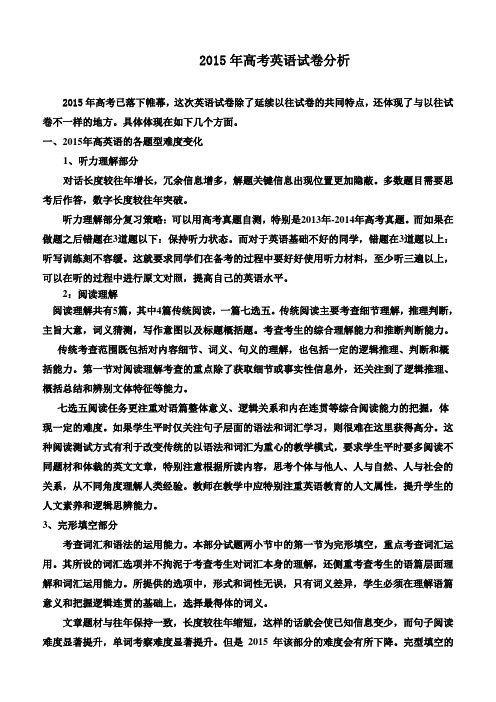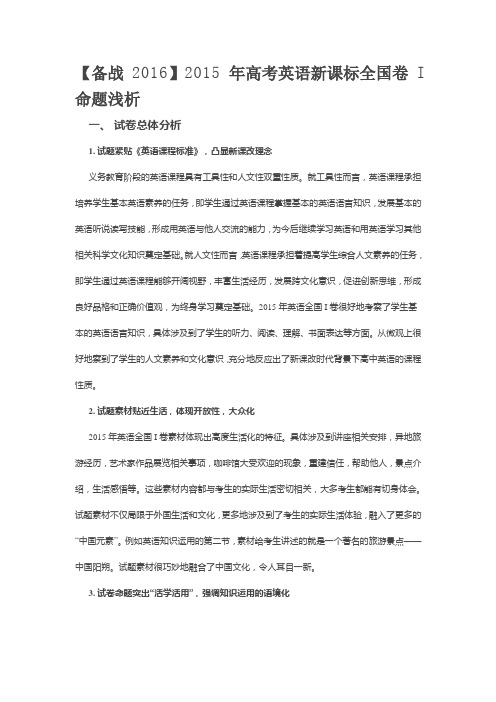2015_2016高考英语全国1试卷分析报告
2015年高考英语试卷分析

2015年高考英语试卷分析2015年高考已落下帷幕,这次英语试卷除了延续以往试卷的共同特点,还体现了与以往试卷不一样的地方。
具体体现在如下几个方面。
一、2015年高英语的各题型难度变化1、听力理解部分对话长度较往年增长,冗余信息增多,解题关键信息出现位置更加隐蔽。
多数题目需要思考后作答,数字长度较往年突破。
听力理解部分复习策略:可以用高考真题自测,特别是2013年-2014年高考真题。
而如果在做题之后错题在3道题以下:保持听力状态。
而对于英语基础不好的同学,错题在3道题以上:听写训练刻不容缓。
这就要求同学们在备考的过程中要好好使用听力材料,至少听三遍以上,可以在听的过程中进行原文对照,提高自己的英语水平。
2:阅读理解阅读理解共有5篇,其中4篇传统阅读,一篇七选五。
传统阅读主要考查细节理解,推理判断,主旨大意,词义猜测,写作意图以及标题概括题。
考查考生的综合理解能力和推断判断能力。
传统考查范围既包括对内容细节、词义、句义的理解,也包括一定的逻辑推理、判断和概括能力。
第一节对阅读理解考查的重点除了获取细节或事实性信息外,还关注到了逻辑推理、概括总结和辨别文体特征等能力。
七选五阅读任务更注重对语篇整体意义、逻辑关系和内在连贯等综合阅读能力的把握,体现一定的难度。
如果学生平时仅关注句子层面的语法和词汇学习,则很难在这里获得高分。
这种阅读测试方式有利于改变传统的以语法和词汇为重心的教学模式,要求学生平时要多阅读不同题材和体裁的英文文章,特别注意根据所读内容,思考个体与他人、人与自然、人与社会的关系,从不同角度理解人类经验。
教师在教学中应特别注重英语教育的人文属性,提升学生的人文素养和逻辑思辨能力。
3、完形填空部分考查词汇和语法的运用能力。
本部分试题两小节中的第一节为完形填空,重点考查词汇运用。
其所设的词汇选项并不拘泥于考查考生对词汇本身的理解,还侧重考查考生的语篇层面理解和词汇运用能力。
所提供的选项中,形式和词性无误,只有词义差异,学生必须在理解语篇意义和把握逻辑连贯的基础上,选择最得体的词义。
2015全国英语高考新课标卷1试卷分析

2015全国英语高考新课标卷1试卷分析将近三年来的试卷和2015的全国高考新课标卷1的试卷对比之后,特别是将2014和2015的对比之后发现:总体来说,2015年全国英语高考新课标卷1的试卷难度和去年相差无几,作文部分比2014年难度有所下降,但阅读理解题型中的词汇量对比2014年有些提升,更突出对语言的“运用能力”的考查。
现将今年试卷的主要特点归纳如下:一、单选题被语法填空题所取代,题目要求有所变化。
从2014年起单选题就已有变革,即取消了单选题型,改成了语法填空题。
其目的是考查学生运用语法知识的能力,完全排除了过去“蒙答案”的可能性。
2015的语法填空题跟2014年相比的变化之处在于:2014年题目中明确要求在空白处所填内容不多于3个单词,而2015年题目中明确要求的是在空白处所填内容不多于1个单词,这样就适当降低了该题型的难度。
2015年的语法填空题型中涉及了时态、介词、代词、名词单复数、定语从句关系词、非谓语动词、副词等词形变换的考查,整体突出考查实词的运用。
对于语法基础较为扎实的考生来说,接近于送分题,但对于完全不懂语法的考生来说是丢分重地。
短文改错题也是类似情况,命题人专挑考生容易错的地方设题。
短文改错部分涉及了冠词、时态、连词、介词、形容词副词、代词、名词的可数与不可数等用法考查。
如果没有一点的语法基础,该部分的丢分率也会相当高。
这两种题型对于福建考生而言都是全新的题型,因此在今后的迎考备考中应当夯实语法基础,增加新题型的训练。
二、今年高考的阅读理解和完形填空题的选材新鲜,话题时尚。
2015年全国英语高考新课标卷1的完型填空更多是夹叙夹议的文章,这与我们福建卷完形填空的题材较为类似。
往年福建卷完形填空也多为夹叙夹议的文章,试图让学生通过文章的阅读有所感悟。
但是两者在词的考查方面略有不同,如今年考查短语爱上be soft on,在平时教学中几乎没有涉及到这个短语的提及。
因此今后在教师在词的讲解中要有所突破,要有所为有所不为,这对教师能力又是一个更高的要求。
2015年高考英语新课标I试卷分析-3页文档资料

2015年高考英语新课标I试卷分析一、听力部分――难度稳中有降听力语速适中,对话简洁实用,内容贴近生活,趣味性强。
题型的设置既侧重信息的筛选和转化,又要求考生通过把握全文的主旨大意理解作者的意图,从而正确应答。
例如:1、6、11题是就材料中包含的时间提问;7、10、16题则是对地点的提问;而15、17题考生则需对涉及到的数字进行简单的计算。
这些题型要求考生必须对把握关键信息有足够的敏感性和沉着冷静的良好心理素质。
4、5、12、13、20题对考生则提出了更高的要求,不仅要把握材料的基本和重要信息,还需正确理解全文的主旨大意,并对这些信息进行快速的整理、理解和推测,方能选出最佳答案。
总之,听力对大多数考生来说是较易拿分的题型,学生们通过平时大量的训练和积累,往往都能得心应手的作答,这就为学生的后续答题提供了良好的开端。
二、阅读理解部分――侧重文化意识的提升阅读理解是英语高考试卷中所占比重最大的,本次阅读理解的特点是:选材以说明文为主,与西方国家文化生活息息相关,侧重对文化意识的考察。
A篇介绍了在伦敦运河博物馆召开的4次月论坛活动的主题和发言人等信息;B篇为作者在美国佛罗里达的旅游经历,侧重于介绍当地的农场特产――番茄;C篇介绍的是法国蓬皮杜中心的达利艺术展览;D篇介绍了法国巴黎开设让顾客能够敞开心扉的心灵咖啡店的社会背景和价值,体现了人文关怀。
15道题的类型仍为细节理解、推理判断、主旨大意、作者的情感态度等方面。
21、22、23、32题为细节题,都能从文章中直接找到答案,基本属于送分题;25、27、28、29题也可以归为细节理解题,但需要考生对细节部分进行推理判断才能选出正确答案;26、33、34、35题为推理判断题,考生需要把握文章的深层次涵义方能应答;30题属于主旨大意题,31题为猜测词义,24题为作者的情感态度,这些题同样需要考生正确理解全文才能选出最佳答案。
总之,四篇文章的选材和题型的设计充分体现了新课标对考生的要求,侧重于考察学生整体把握信息和推理判断的能力和提升考生的文化意识。
2015高考全国新课标Ⅰ卷英语试题评价与解析

注意听力语料的选择。 注意微技能的分解练习。 注意对话场景的分类练习和积累。 注意语音现象:重音、语音语调、 连读、失去爆破等。 注意坚持练习,培养良好的听力解 题习惯。
听 力 备 考 指 导
2015新课标一卷试题解析—阅读理解
应用文
3题 通知类
记叙文
4题 个人经历
说明文
4题 艺术题材
2015年高考题解析及点 评 (英语新课标一卷)
2015新课标一卷试题总体评价
2015英语试题体现了大纲和说明的要求: “注重基础,强调运用”、“能力考查
为主,知识考查和能力考查相结合”,
延续了以往的高考英语的命题思路,难
度适中。试题中规中矩,重点考查考生
对基础知识的掌握和语言的综合运用能
力。
2015新课标一卷试题总体评价
charge: N/V ①the amount of money you have to pay for goods or services 要价 an admission charge of $5 Guided tours are provided at no charge . ②the position of having control or responsibility for a group of people or an activity负责/控制 Owens came in and took charge of (=took control of) the situation. ③an official statement made by the police saying that they believe someone may be guilty of a crime控告 He was found guilty of all six charges against him. ④ electricity that is put into a piece of electrical equipment such as a battery电 Leave the battery on charge all night.
2016年高考英语(新课标I卷)试卷分析报告

2016年高考英语(新课标I卷)试卷分析报告2016年高考英语(新课标I卷)试卷分析报告今年的英语试题总体上仍是稳中求变,保持了近几年高考英语学科命题的一贯思路和风格,整体难度适中。
试卷内容从英语学科的核心素养出发,注重考察学生的基础语言能力、文化意识、思维品质和学习能力,充分体现了教育部提出的“一点四面”的基本原则。
充分体现了“注重基础,强调运用,突出能力,稳中求变”的命题原则。
在立足于应用的前提下,试题更加侧重对学生英语综合能力的考查,较好地体现了英语《新课程标准》的要求,并且在此基础上有所突破。
对情感态度、学习策略和文化意识的考查渗透在对语言知识与语言技能的考查中,突显了英语高考试题的综合性、文化性、实用性、社会性、新颖性,也体现了新课改的趋势和要求。
一、听力2016年高考英语听力(新课标1卷)同往年相比变化不大,全面考查了学生在语境中理解和获取信息的能力。
材料语言地道,信息点丰富,设题方面,依然以事实细节题为主,题目设置比较灵活,整体上有9个左右的灵活题。
本套试卷的听力主播是Kris & Laura,与去年一致;速度为150~155 wpm;总字数约为871字。
1. 听力材料围绕日常生活的话题展开,请见下表:2. 试题特点:(1)信息点密集,尤其体现在数字题。
如第11、12、13、14、19题。
11. When will the woman arrive at the hotel?A. On September 15.B. On September 16.C. On September 23.12. How much will the woman pay for her room per night?A. $179.B. $199.C. $219.19. What percentage of student job seekers have found a job by now?A. 20%B. 22%.C. 50%.此三题的选项均来自于材料,而且形成了密集干扰,考生需要边听边记笔记,辨别不同数字所对应的信息。
备战2016 2015年高考英语新课标全国卷1命题浅析

【备战2016】2015年高考英语新课标全国卷I 命题浅析一、试卷总体分析1. 试题紧贴《英语课程标准》,凸显新课改理念义务教育阶段的英语课程具有工具性和人文性双重性质。
就工具性而言,英语课程承担培养学生基本英语素养的任务,即学生通过英语课程掌握基本的英语语言知识,发展基本的英语听说读写技能,形成用英语与他人交流的能力,为今后继续学习英语和用英语学习其他相关科学文化知识奠定基础。
就人文性而言,英语课程承担着提高学生综合人文素养的任务,即学生通过英语课程能够开阔视野,丰富生活经历,发展跨文化意识,促进创新思维,形成良好品格和正确价值观,为终身学习奠定基础。
2015年英语全国I卷很好地考察了学生基本的英语语言知识,具体涉及到了学生的听力、阅读、理解、书面表达等方面。
从微观上很好地察到了学生的人文素养和文化意识,充分地反应出了新课改时代背景下高中英语的课程性质。
2. 试题素材贴近生活,体现开放性,大众化2015年英语全国I卷素材体现出高度生活化的特征。
具体涉及到讲座相关安排,异地旅游经历,艺术家作品展览相关事项,咖啡馆大受欢迎的现象,重建信任,帮助他人,景点介绍,生活感悟等。
这些素材内容都与考生的实际生活密切相关,大多考生都能有切身体会。
试题素材不仅局限于外国生活和文化,更多地涉及到了考生的实际生活体验,融入了更多的“中国元素”。
例如英语知识运用的第二节,素材给考生讲述的就是一个著名的旅游景点——中国阳朔。
试题素材很巧妙地融合了中国文化,令人耳目一新。
3. 试卷命题突出“活学活用”,强调知识运用的语境化2015年英语全国I卷整体偏易,注重考察学生的英语语言基本技能和学生运用英语基础知识的能力。
试卷和过往两年一样不再是单纯的考察学生的英语知识,而是更为强调学生结合具体语言环境,从文章主题思想,社会正能量,生活实际体验和科学的世界观、价值观等方面“活学活用”。
例如,阅读理解的28题,该题要求考生从选项中选出一个最恰当的词来描述“Dali”,考生需要很好地理解文章的含义,并掌握“Productive”一词的含义,然后结合具体语境才可选出该正确选项。
2015年高考英语全国卷1试题分析

2015高考新课标I卷英语试题分析(阅读&完型)2015-06-11 17:04:59 来源: 网易教育频道综合分享到:••••••••2015高考新课标I卷英语试题分析(阅读&完型)新东方在线李辉2015年高考英语考试刚刚结束,新东方在线名师第一时间为大家带来新课标I卷英语试题解析。
首先是听力,听力的话同学们都说这都不算分了,你在听听力的时候就把第一篇阅读理解做完了,从大题来讲阅读理解分为记叙类。
第二种叫说明类,第三种叫做观点类,也叫议论类,第四类就叫找你妹。
一共是这么四种类型,这种就是属于典型的找你妹的类型,直接找就完了。
如果有时间可以把第一自然段看一下,看看整篇文章探讨的是什么事,在伦敦的一个博物馆的每月的谈话就完事了,直接去做题,后面的每道题目都一样。
这个GB 的谈话在什么时候,做这种题目就直接找答案,这就属于信息阅读。
现在是互联网社会,网上有这么多的信息,你到底该学什么样的信息呢?什么样的信息是有用的东西呢?你要去进行寻找和筛选,而这种题目就是考察同学们去寻找和筛选的能力。
直接可以找到,那什么时间?就是11月7号。
什么是主题?在二月份的谈话的主题是什么,你直接看二月份就知道主题是什么了。
23题说(Who will give the talk on the islands in the Thames?),在这个什么(Thames)),这个东西其实你不认识都行,就是泰晤士河,你找这个小岛就完事了,所以这道题加一块三分钟就可以找对答案。
一、阅读理解第一篇文章讲的是非常寒冷的东北,并不是一个特别好玩的地方,东北不是个过冬的好地方,因为太冷了。
那么机会来了,周末去这么一个地方,我的包打好了,要旅行。
我就去了一个温暖的地方,这个地方是去佛罗里达,这可不是东北,是美国最温暖的地方,去了有一个有阳光的地方。
想着这个沙滩以及橘子树,第一自然段得全读完才知道讲的是什么。
(touch down),这个单词特别的协调生动,叫触地得分,就是着陆了,达到阳光和空气温暖的地方,我做了一个简单的祷告。
2015高考全国卷英语试卷分析

全国新课标高考英语试卷分析一、新课标全国卷分值和试卷结构:新课标全国卷卷面总分120分,其总分按135进行折算,折算公式为:最终成绩= 卷面考查依据(新课程标准和考试大纲)、考试目标与要求、考试范围与内容、考试时间、试卷基本结构(不含听力)、选择题(不含听力)题目数量相同。
二、题型分析全国卷首先考查阅读理解,再层递式考查进行综合运用能力测试的完形填空,更重要的是全卷分成了“I卷”“II卷”,有利于客观题与主观题的题号顺序排列和考生答题思维的过度,理论上更科学,在试卷的梯度上,全国卷布局更为合理。
1)阅读理解四篇短文,每篇文章3-4个小题,2015年四篇短文中有3篇设计4小题,另一篇3小题,短文稍短,并且不同文章长短悬殊(2015年,最长354词,最短194词),测试题型涵盖事实细节、判断推理、词句理解、主旨大意、态度意图等,难度上要比广东卷低一点;题材丰富,话题广泛,文体多样,但夹叙夹议的文章比重越来越大。
15年问题题干不长,多采用问题形式设题,学生易懂。
但是,貌似简单短小的文章时不时地会出现几个合成词,同根词或者其他大词难词,阻碍着学生的理解,同时,全国卷设题的手法和思维角度也略有不同,看似没有广东的大气,却总是挑战着学生的习惯思维。
近两年考点设计:2)短文选句(七选五)此题和广东卷的信息匹配有相似之处,难度却大多了。
2015年短文涵盖268个词,考查学生对文章整体框架脉络的把握,对主题句的把握,对前后上下文逻辑发展的把握,因此要求学生要从句义上、词汇上、关联词上寻找并加以判断。
3)完形填空a.全国卷的完形填空篇幅相当,但增加了五个小题,也就意味增加了设空的密度,减少了信息量,题目的难度自然加大了。
b.考点主要是围绕实词,但也有例外:(15全国卷)54.A. whoever B. whatever C. whichever D. whenever虽然这是一个偶然,但因为连词更能考查学生对语篇逻辑思维的能力,也许这也是一个值得关注的新动向。
- 1、下载文档前请自行甄别文档内容的完整性,平台不提供额外的编辑、内容补充、找答案等附加服务。
- 2、"仅部分预览"的文档,不可在线预览部分如存在完整性等问题,可反馈申请退款(可完整预览的文档不适用该条件!)。
- 3、如文档侵犯您的权益,请联系客服反馈,我们会尽快为您处理(人工客服工作时间:9:00-18:30)。
2015—2016高考英语全国1试卷分析
1. 2016年试题分值
2. 2015年和2016年试题各类题型的考点分布比较
(1)听力
A. 2016年高考英语听力(新课标1卷)的材料:
本套试卷的听力主播是Kris &Laura,与去年一致;速度为150~155wpm;总字数约为871字;设题方面,依然以事实细节题为主;难度方面,整体上有9个左右的难度题
B. 2015年高考英语听力(新课标1卷)的材料:
本套试卷的听力主播是Kris & Laura,;速度为150-155 wpm;整套材料的词数约为731个单词,为近5年来最少;设题方面,依然以事实细节题和推理判断题为主;难度方面,整体上有10个左右的难度题。
C. 教学建议:
(1)平时多听多练,熟悉常考话题;
(2)选择信息点丰富,选项干扰强的材料;
(3)培养语言灵活转换的能力。
(4)训练并逐步提高对长难句的分析和理解能力。
(2)阅读理解(包含七选五)
(3)完形填空
完形填空考查考生在阅读理解的基础上对词汇知识的掌握情况。
要求考生通读全文,掌握文章大意,运用词汇、语法等知识,选择最佳答案,使文章意思通顺,结构完整。
记叙型完形填空是高考和备考的重点。
(4)语法填空
这一题型的出现改变了以往用单项填空来考查语法的形式,代之以在短文或者在以具
体生活情境为内容的对话中考查语法的灵活运用,难度显然要高于原来的单项填空。
(5)短文改错
短文改错的文章内容浅显,词数为100左右,多采用记叙文文体,偶尔也有说明文和应用文。
短文改错试题检测考生在改错和书写的过程中,在语篇和上下文理解中运用语言知识去解决实际的语言问题。
具体来说,短文改错主要检测考生发现、判断、纠正文章中错误的能力,以考查考生在语篇中综合运用英语知识的准确性。
考点涵盖知识的领会、运用、分析、综合等诸多方面,考查目标既涉及语言知识的多个方面(词法、句法、语篇结构、行文逻辑等),又涵盖理解、分析、运用和整体思维等诸方面能力。
(6)书面表达
书面表达主要考查了学生对语言的综合运用能力。
近两年全国卷书面表达都是书信体
的文章,学生都有可写的东西。
